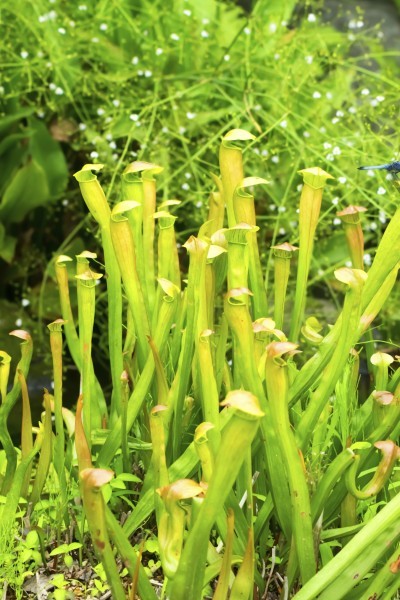






There are over 700 species of carnivorous plants. The American pitcher plant (Sarracenia spp.) is known for its unique pitcher shaped leaves, bizarre flowers and its diet of live bugs. Sarracenia is a tropical looking plant native to Canada and the U.S. East Coast.
Growing pitcher plants outdoors requires a combination of conditions quite different from ordinary garden plants. Garden grown pitcher plants love nutrient poor soil that is deficit in nitrogen and phosphorus. In their native environments, pitcher plants grow in highly acidic, sandy, peat-rich soil. So normal soil nitrogen levels can kill pitcher plants and also invites other competitive plants into their growing space.
Pitcher plants in the garden also require full sun. Shade or partially-sunny spots will cause them to weaken or even die. Some other pitcher plant info that is important to note is their requirement for a highly humid environment and rather pure water. Pitcher plants don’t like chlorinated water. They prefer either distilled water or rainwater.
Garden grown pitcher plants should be placed in a container that can hold water. A tub, a pot without holes at the bottom or even a do-it-yourself bog garden will work. The trick is holding enough water so the lower portion of the roots are wet but the top portion of the growing medium is out of the water.
Aim for a steady and consistent water level 6” below the soil. Monitor the water during your rainy season so it doesn’t get too high. Drainage holes or channels should be placed about 6” below the plant in the growing medium. You will have to experiment with this until you get it right. Do not pour water into the pitchers or fill up the pitchers with bugs. That will overwhelm their systems and possibly kill them.
It you want to create a bog, you should dig out an area and fill it with peat or peat mixed with compost from carnivorous plants. Do not use normal compost. It is too rich for pitcher plants in the garden. Otherwise, 3 parts peat moss to 1 part sharp sand should suffice as your planting medium.
Make sure your pot, tub or homemade bog is in full sun. Protect the area from the wind. That will dry out the air space. Do not fertilize your pitcher plants.
As you can see, care of pitcher plants outdoors involves some complexity. But it is worth it to watch these exotic plants grow and perform!
Copyright © www.100flowers.win Botanic Garden All Rights Reserved